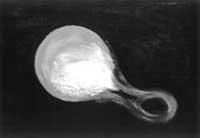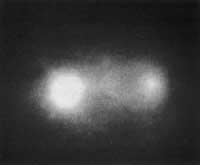Black hole in the core of the French Way
1994/02/01 Arregi Bengoa, Jesus Iturria: Elhuyar aldizkaria
In the topic chosen for this article, as for the possible black hole in the center of the French Way, some have dared to limit the deadline. The resolution of the tooling we will have in about four years will be enough to decide the debate.
As is known, the black hole is a collapsed mass that produces a gravitational field that does not allow the light itself to be expelled from its limits. Since there is no radiation or anything from it, the affirmation of existence must be done by studying the effects that can influence the environment. According to theory, matter that could exist around the black hole would fall toward it, but not uniformly in all directions.

Approaching the limit of the black hole, matter forms a disc, a swirl that runs along the abyss path at a vertiginous speed. Because within this disc matter moves so fast and friction and collisions are so violent that atoms cannot maintain their structure either. Matter is thus in a plasma state, like a broth of basic fractions.
The temperature can reach hundreds of millions of degrees. The enormous energy released by these processes expands in the rays of all fields of the spectrum, but especially in X-rays and gamma, as they are the ones that carry the most energy. The Earth's atmosphere acts as a filter against these rays, so it is not possible to collect them with instruments located on the Earth's surface. Hence the importance of satellites. In order to “see” the different types of rays, satellites have been used to put the appropriate telescopes to work on the atmosphere. As an example, it is worth mentioning that the infrared area has been studied through the satellite IRAS, the ultraviolet with IVE, the x-ray with EXOSAT, ROSAT, Ginga and GRANAT and the gamma ray with GRO.
Radio and microwave emissions can be detected from Earth. The study of radio sources revealed the violent Sagittarius A*, which is in the center or very close to our galaxy. Due to its location, special attention has been paid to this source and the results of X-ray and gamma satellites in this area have been carefully analyzed.
In the summer of 1990 a group of astronomers from Harvard University discovered, through observations made from the earth's surface, that the source of Sagittarius A* resembles the whirlpool described above. The discovery was made using the 27 antenna system (VLA, Very Long Array), located in Socorro (New Mexico). The infrared emission of increasing intensity measured outwardly inward is considered generated by increasing friction, which denounces the spiral structure.
On the other hand, using the structure of the radio telescopes (VLBA structure, Very Long Baseline Array) that are thousands of kilometers away from the earth's surface, the dimensions of the disc being described were also approximate. The radius of the radiation source could be similar to that of Jupiter's orbit.
However, although the model we have given is consistent, simple radio and infrared emissions cannot be considered as evidence of the existence of the black hole. Therefore, as indicated above, X-ray and gamma ray signals were enthusiastically collected, but the radiation recorded in these areas has not met expectations. It was very difficult to detect high-energy radiation in the direction of Sagittarius A*. Finally, in 1991 the GRANAT satellite received a weak X-ray emission, while in January last year the GRO collected gamma rays (also weak) from a region of 50 light-years in diameter around the center of the galaxy.
For those who say that there is a black hole in the center of the French Way, that violent rays are scarce is not an insurmountable problem. The black hole may drop little gas and be slowed down. M. J. The central idea of Rey's argument is that most galaxies are believed to have active regions in the early stages of their evolution.
J. According to Trümper, ROSAT has detected about 25 thousand galaxies with an active zone. Theorists consider the creative energy of these spaces as massive black holes. If this wind is direct in the ancient galaxies, they must be scattered in the universe by this type of black holes. If things have happened like this, on the French Way there can also be a black hole like those mentioned.

F. Melia has developed an adequate and solid model based on the previous hypothesis. Describes emissions of radio waves, infrared waves and X-rays in a black hole, rolling, considering that it is produced by a disc of hot matter that is immersed. It is estimated that the mass of the black hole would be 900,000 times greater than that of the Sun and its diameter would be about 100 million kilometers, that is, approximately that of the orbit of Mercury. However, it cannot yet be said that everything is clear. Among other things, Sagittarius A* is not the only source of X-rays and gamma that has been found around the dynamic center of the galaxy, and a suitable explanation must be found for others.
As mentioned above, the black hole that could be in the core of the French Way would be none other than one that could exist in many other galaxies. Therefore, it would not be surprising, though difficult, to find these dark stars in other galaxies. In fact, structures similar to those we have just analyzed have been found as: Galaxy M-87 to 45 million light-years from Earth; galaxy NGC 3115
The Hubble Space Telescope has also found some possible black holes: For example in galaxies M-51 and M-32. The first is 20 million light-years from Earth, with a diameter of 100 light-years and a black hole in its core that could contain a million masses of Sun. The gas surrounding the black hole spirals 800 km/s. The second one is 2,300,000 light-years from Earth and in it the black hole mass would be three times greater than that described for the French Way.
If the forecasts are met, we will not have to wait long to know if there are black holes in all the cases mentioned.
Ephemeris SUN: February 18, 21h 21min. enters Pisces.
PLANETS MERCURY: we can see it in early February at dusk. Reaches its maximum elongation on day 4. |

Gai honi buruzko eduki gehiago
Elhuyarrek garatutako teknologia





